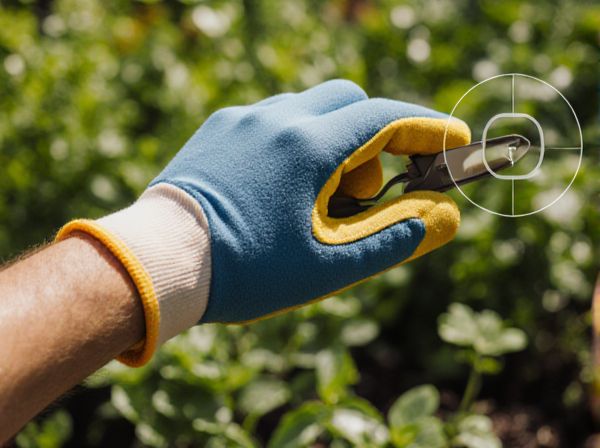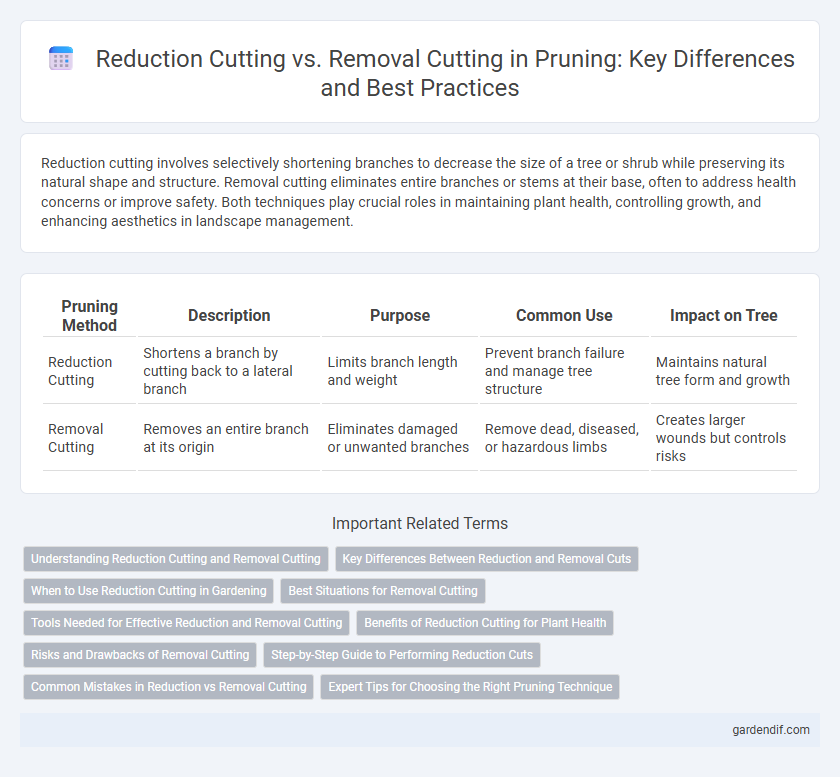
Reduction Cutting vs Removal Cutting Illustration
Reduction cutting involves selectively shortening branches to decrease the size of a tree or shrub while preserving its natural shape and structure. Removal cutting eliminates entire branches or stems at their base, often to address health concerns or improve safety. Both techniques play crucial roles in maintaining plant health, controlling growth, and enhancing aesthetics in landscape management.
Table of Comparison
| Pruning Method | Description | Purpose | Common Use | Impact on Tree |
|---|---|---|---|---|
| Reduction Cutting | Shortens a branch by cutting back to a lateral branch | Limits branch length and weight | Prevent branch failure and manage tree structure | Maintains natural tree form and growth |
| Removal Cutting | Removes an entire branch at its origin | Eliminates damaged or unwanted branches | Remove dead, diseased, or hazardous limbs | Creates larger wounds but controls risks |
Understanding Reduction Cutting and Removal Cutting
Reduction cutting involves selectively trimming branches to decrease size while maintaining the natural shape and structural integrity of the plant. Removal cutting focuses on entirely eliminating specific branches or stems to improve plant health, enhance air circulation, and prevent damage. Understanding the distinct purposes of reduction and removal cutting helps optimize pruning practices for better growth management and disease prevention.
Key Differences Between Reduction and Removal Cuts
Reduction cutting decreases the size of a tree branch by shortening it to a lateral branch that is at least one-third the diameter of the cut stem, helping to maintain tree structure and health. Removal cutting completely eliminates a branch at its point of origin, which can be necessary for dead, diseased, or hazardous limbs but may cause larger wounds. Key differences include the purpose--reduction cuts manage growth without significant damage, while removal cuts are used to eliminate unwanted or problematic branches--and the impact on tree integrity and recovery time.
When to Use Reduction Cutting in Gardening
Reduction cutting is ideal for managing overly vigorous or large branches to maintain the natural shape and size of trees without complete removal. It is used when you want to reduce the length or height of a branch while preserving its structural integrity, especially in fruit trees and ornamental plants. This technique promotes healthy growth, reduces stress on the plant, and improves air circulation and light penetration.
Best Situations for Removal Cutting
Removal cutting is best suited for situations where eliminating specific trees improves overall forest health, such as removing diseased, damaged, or invasive species to promote growth of desired trees. This method is effective in enhancing biodiversity and managing forest composition by selectively targeting individual trees for elimination. Removal cutting also aids in reducing competition for resources, facilitating regeneration in stands requiring ecological balance restoration.
Tools Needed for Effective Reduction and Removal Cutting
Effective reduction cutting requires tools such as sharp bypass pruners, lopping shears, and pruning saws to precisely trim branches while maintaining plant health. Removal cutting demands heavy-duty equipment like chainsaws, pole saws, and sturdy hand saws to safely eliminate large limbs or entire branches. Properly selected tools enhance cutting accuracy, minimize damage, and promote faster healing in both reduction and removal cutting practices.
Benefits of Reduction Cutting for Plant Health
Reduction cutting enhances plant health by minimizing stress on the plant structure, allowing for better nutrient distribution and improved airflow. This method preserves the natural shape and promotes vigorous growth without the shock caused by removal cutting. Maintaining balanced foliage through reduction cutting reduces the risk of disease and supports overall plant vitality.
Risks and Drawbacks of Removal Cutting
Removal cutting poses significant risks such as exposing trees to increased vulnerability from pests and diseases due to large wounds or complete trunk elimination. This method can weaken structural stability, leading to potential tree failure and safety hazards in urban or landscaped environments. Furthermore, removal cutting often disrupts ecosystem balance by abruptly removing key habitat components, which may negatively impact biodiversity.
Step-by-Step Guide to Performing Reduction Cuts
Performing reduction cuts involves systematically shortening a branch back to a lateral branch that is at least one-third the diameter of the cut branch, ensuring the tree's natural structure is maintained and minimizing stress. Begin by identifying the target lateral branch, then make a clean cut just beyond the branch collar to promote healthy healing and prevent decay. This method contrasts with removal cutting, which eliminates entire branches or stems, often used for dead or hazardous limbs, whereas reduction cutting shapes and controls growth without compromising overall tree stability.
Common Mistakes in Reduction vs Removal Cutting
Common mistakes in reduction cutting include cutting too close to the branch collar, which can harm healing and increase disease risk, while removal cutting often involves improper flush cuts that damage the trunk. Misjudging the appropriate cut type for branch size and position leads to excessive tissue loss in removal cutting or inadequate reduction in reduction cutting. Understanding branch anatomy and cutting techniques is essential to avoid tree stress and promote healthy regrowth.
Expert Tips for Choosing the Right Pruning Technique
Reduction cutting preserves branch structure by shortening selected limbs, promoting healthy growth and maintaining tree shape, while removal cutting eliminates entire branches to prevent disease spread or improve safety. Experts recommend analyzing tree species, growth patterns, and desired outcomes to choose the appropriate technique; for example, reduction cutting suits young or structurally intact trees, whereas removal cutting is essential for dead, diseased, or hazardous branches. Proper tool selection and clean cuts optimize healing and tree vitality, emphasizing precision and timing in pruning practices.
Reduction Cutting vs Removal Cutting Infographic

 gardendif.com
gardendif.com